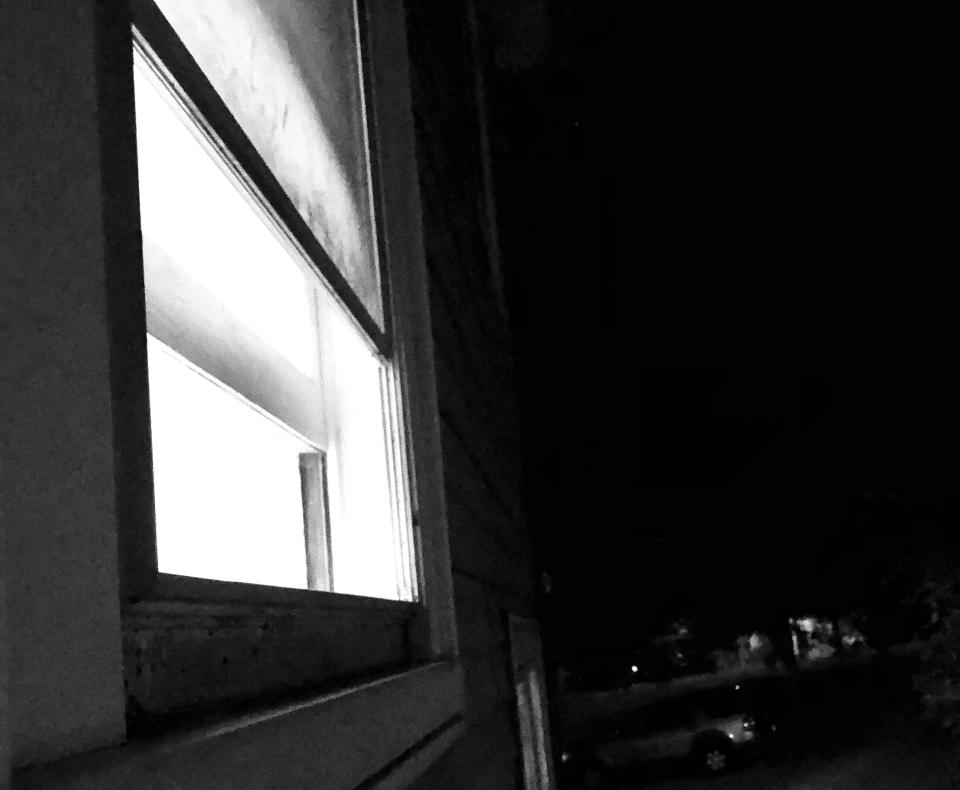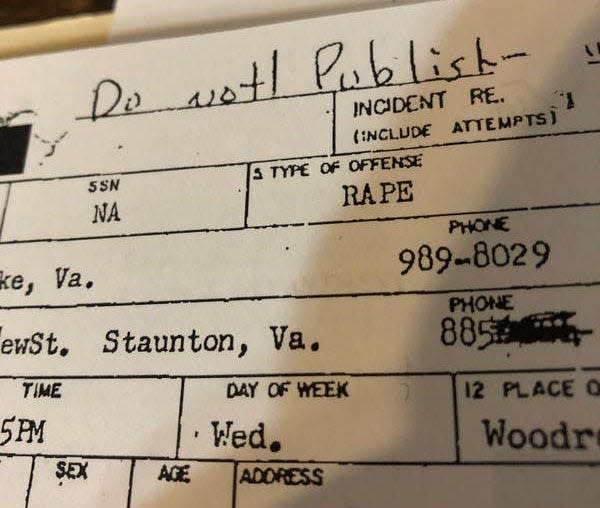Serial rapist stalks vulnerable city while Staunton police, women’s college stay silent
- Oops!Something went wrong.Please try again later.
STAUNTON — At the top of the ladder, in the hot July night, he paused, looking in on a landing between the first and second floors of the house. He popped the screen and the window slid up for him, unlocked, as he knew it would.
It wasn’t the first house he’d broken into. There had been practice. He’d been caught in Roanoke the year before, but his mother had written the court a plea for leniency for her son, and the judge had listened. The two-year sentence had been suspended after 90 days, and he was free.
Just days after moving to this little city in March, the 20-year-old had begun his invasions again.
He hoisted himself up on the sill, then hopped lightly down. He lost his footing for a moment as he landed, and braced himself against the banister; then he hid in a room, and waited.

Crouching in the silence, he knew he had gotten away with it all so far. Next to nothing had appeared in the newspaper to show the police had connected any of his multiple break-ins.
It was July 1, 1979. Since the spring, he’d broken his way into at least five houses; in three of the houses he had stolen female undergarments, as well as an item or two of little value. As police reports noted, he’d overlooked the most valuable jewelry as he’d ransacked dresser drawers. It may be that he could not differentiate between trinkets and true jewels. It may be he was after something else.
Twice, he had surprised women in their homes and raped them.
Waiting now, he was in fact on the same street where he’d raped a Mary Baldwin College student in her dorm room in March. A few months later he had struck again, entering through a window and raping a teenager who was home alone in her house near Gypsy Hill Park.
Neither act of terrifying sexual violence, committed at knifepoint, had been reported in the local news. The police and the newspaper had remained as silent about these life-altering crimes as the man biding his time in the dark.
A door opened on the first floor. From where he crouched he could have heard people conversing at the threshold after a night out, talking and laughing. Female voices. A conversation ending with farewells. Or just the sound of a woman coming home quietly to a dwelling she thought was empty. Then, the sound of the front door closing.
Someone was coming up the stairs.
The intruder took a stocking from his pocket and slid it over his head to just beneath his nose.
He heard the sound of shoes flipped off, and the sigh of shifting sheets and mattress springs as someone lay down in her bed.
He pulled out a pocketknife and thumbed open the blade as he moved toward the bedroom.
*
While James Bruce Robinson was attacking a woman on North New Street, a few blocks from the all-women's college and a stone's throw from three of the city's historic churches, windows all over town were open.
It was a hot summer night in Staunton in the 1970s, and most houses were not air-conditioned.
Leaving your window open was just what you did in Staunton in 1979.
His victim had noticed a ladder propped against her house when she got home, but did not think it was cause for alarm.
"Nobody had any reason to be suspicious," she said in a 2022 interview.

"He waited until I’d gone to bed and put the light out. Then he jumped on top of me with his knife and his stocking mask. It’s one of those things where you say, this can’t possibly be happening, I’m dreaming."
It was a nightmare the city had opened itself up to because its citizens were not warned.
Brenda Canning lived downtown most of her life. She was not involved in the case, but could easily have been a victim: "I always left the window up, at the landing of the stairway," she said.
Since it wasn’t public knowledge that a rapist was entering homes through unlocked windows, Staunton’s young women — many living alone — continued to unknowingly place themselves at risk, Canning and her friends among them.
Most of city's women didn't yet know that a rapist was on the loose, but the cops did.
The Staunton Police Department knew the rapist’s method well before July. They were aware he was rare among sexual offenders — a stranger to both women he assaulted in March and June, even though most rapists are known by their victims.
On the top of the police report for each of these rapes, the words “Do Not Publish” were handwritten by the same person who initialed the “Supervisor Approval” line at the bottom of the page: Staunton Chief of Police J.M. Boyers.
Police also were aware of a string of break-ins in which women’s undergarments were stolen, but they weren’t reporting those crimes to the press. Or if they were, they weren't appearing in an otherwise thorough police blotter which detailed less invasive infractions along with bigger crimes.
The Boston Strangler case almost 15 years earlier had shown the peril the public faced when police assumed a criminal with a history of breaking-and-entering crimes wouldn't escalate to sexual assault or murder. But Staunton wasn’t Boston. It was far safer, everyone thought, and the police weren’t warning the general public that someone dangerous was prowling the city in 1979.
Neither was its newspaper, known then as The Staunton Leader, the city’s family-owned daily paper since 1890.
Police had no leads. He was an evil shadow without a name. To those he attacked and horribly traumatized, he didn’t even have a face; he wore a stocking over his head.
*
“I had to feel the pain.”
Judging from 82-year-old Noreen Renier’s voice on a 2019 call from Florida to Staunton, the hurt doesn’t go away even four decades later. It was not her pain, but she became familiar with it over that awful year.
It started at the local community college, with a ring placed in her hand by a rape survivor’s sister.
What happened next launched a chaotic career for Renier as a high-profile psychic, who would go on to work with other police departments across the country and become the first and only psychic who would lecture at the FBI training academy in Quantico.
Speaking at Blue Ridge Community College in the late fall of 1979, she was approached by a young woman who asked her to perform a public service. She said her sister had been raped. The police had no leads.
Renier practiced what she called psychometry. The practice works on the idea that events leave traces or memories on inanimate objects. Renier said she could sometimes sense these trace memories and find herself in the middle of the experience as if she was living through it in the moment.

The woman handed Renier a ring and listened as the psychic held the ring and began talking. What she said was convincing enough for the sister to take to the Staunton police and insist that they bring her in to help.
A few weeks later, the psychic would visit the scene of that crime at the police’s request and put herself literally in the place of the victim, on her bed, to describe details that made a reluctant believer out of the commonwealth’s attorney.
Renier stated that the rapist had climbed a ladder and opened the window on the stair landing.
While in a trance-like state, she drew a curious circle pattern on her notebook, saying the criminal drove something that went around and around.
The police said nothing, but they took her to the house of the second victim as well.
On leaving, she was asked if she had any more insights about the man they were seeking.
“You’ll catch him by Christmas,” she said.
*
Before he left the house for the humid summer night, the man with the stocking mask on his head took $13 from his victim’s purse. She was unaware that her attacker had been in her apartment a few months before and had stolen a Westclock alarm, a hand-painted candy box and a garnet ring.
Serial predators take souvenirs. In 1979, some Staunton women came home from a day at work to find a dresser drawer open, undergarments strewn about.
Then women noticed panties and other undergarments missing after a break-in, while other more valuable items were left untouched in their jewelry boxes.
The stocking mask rapist would later claim he often threw away the clothing. But now and then a particular item would call to him and he’d take it, such as the garnet ring he stole from North New Street.
Another ring would bring Noreen Renier into the orbit of the case, and when he was captured, some of the details about him she provided police likely convinced law enforcement they finally had the rapist in custody on a trespassing charge.
But first, two more women would be tragically victimized, and a city would erupt with fear and false accusations. “Five concerned women” would force the newspaper’s hand to publish details about the crimes.
And in the white-dominated Southern city, amid pervasive institutional racism, it would be revealed that an innocent Black man had been incarcerated since March for the first rape even as the real rapist worked his way at will across downtown at night.
That would not be the only false arrest before the year was over.
— Jeff Schwaner is a journalist at The News Leader in Staunton and a regional storytelling and watchdog coach in USA TODAY Network-Southeast. Contact him at jschwaner@newsleader.com.
NEXT UP IN "THE STOCKING MASK"
Everything changed when an amateur psychic became involved in the case on the insistence of a Staunton victim’s sister. A tall and striking woman from over the mountain in Ruckersville, the psychic told them things that only the police and the rapist’s victims knew. And more.
Including her directions to look for a handprint, the sole piece of physical evidence in the case; and how she was sure the rapist lived across the street from a theater, a detail which would prove vital to an investigation a special agent would call one of the most important of his career.
PART 1: Serial rapist stalks vulnerable city while Staunton police, women’s college stay silent
PART 3: Cops admit predator is at large. Staunton women told to use ‘can of hair spray’ for defense.
PART 4: ‘Everyone’s scared to walk outside their houses — or stay in them’
PART 6: ‘You got two innocent people in jail, and a rapist still out there’
PART 7: Women make demands. A psychic makes predictions. And a Virginia city holds its breath.
PART 8: Things go ‘round and round’: Two unlikely sources help police close in on Staunton predator
PART 9: After a year of dread and violence, a Staunton suspect confesses, but is there evidence?
This article originally appeared on Staunton News Leader: Stocking mask rapist terrorized Staunton VA in 1979: History of case

